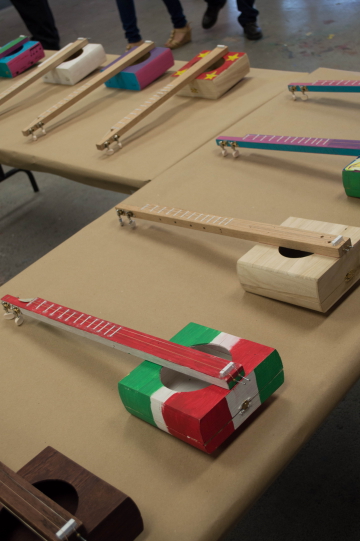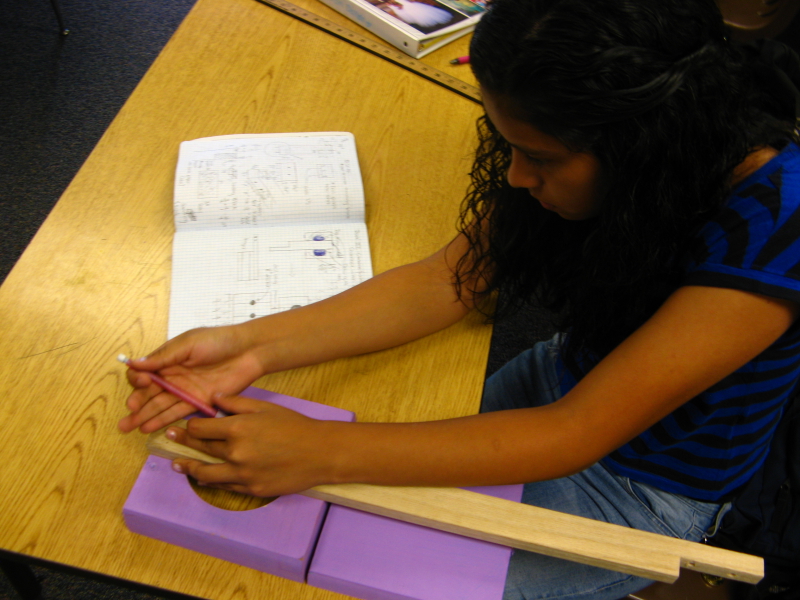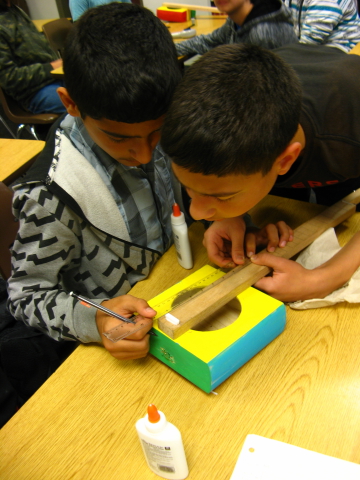Donate!
Please help us on our journey to raise $100 million!
 The sound of an electric drill. The banging of a hammer. And in the distance, the faint sound of wood being sawed.
The sound of an electric drill. The banging of a hammer. And in the distance, the faint sound of wood being sawed.
You would think that you’re at a construction site for a new building. No, thirty eighth-grade students are either working in groups, partners, or by themselves to build a two-stringed jewelry box guitar. This music project incorporated math lessons with basic operations using decimals, fractions, integers, as well as multiple concepts from geometry.
A few weeks earlier, a teacher stopped me in the copy room and exclaimed, “you’re going to allow them to use those power tools and do what? Do you understand what kind of kids you have?”
She was a seventh-grade teacher. She had these students the year before and had a tough time with them behaviorally. She was concerned about the students’ safety.
 All thirty students are, what the state of California labeled as, “far below basic” or two levels below where they should be (based on standardized test scores). And their math skills reflected this. Most of the students barely knew their multiplication table or how to add or subtract single digits properly. My job was to catch them up from third-grade math to eighth-grade math.
All thirty students are, what the state of California labeled as, “far below basic” or two levels below where they should be (based on standardized test scores). And their math skills reflected this. Most of the students barely knew their multiplication table or how to add or subtract single digits properly. My job was to catch them up from third-grade math to eighth-grade math.
The teacher in the copy room was right to a certain degree. You can’t just put power tools into the hands of any student and expect them to behave with those tools.
 Up to that point in the school year, I had been working hard to build the students’ esteem, confidence, as well trust. The class had developed a sense of community. Norms had been established. And most importantly, students felt that the classroom was a safe place to learn as well as make mistakes.
Up to that point in the school year, I had been working hard to build the students’ esteem, confidence, as well trust. The class had developed a sense of community. Norms had been established. And most importantly, students felt that the classroom was a safe place to learn as well as make mistakes.
When I felt like these elements were in place, I could then empower my students by allowing them to work with autonomy, even with power tools.
Although there were universal requirements for this project, students were given control of how long the neck of their guitar could be, how they wanted to design the body, and what song they wanted to write and play. It is this autonomy that made my students feel like they were in control of their own learning.
By the end of the year, and after another standardized test, most of my students were now relabeled “basic” (or at-level). Students knew that they were capable of learning and achievement. They felt that, with the right kind of effort, they could excel like other students.
Students who feel in control of their own learning will perform better as a result.

Empowerment is one of the three values at Academy of the Renaissance.
It is reflected in each of our six pillars. In the example above, you can see how we empower students through learning. This is also part of character development where students build qualities that will enable them to succeed at school and life. Intergenerational learning empowers older students by giving them the responsibility to guide younger students. Mastery of strengths focuses on developing self-confidence in at least one academic area. Community development allows students to resolve issues that are often reserved for adults. And when students develop the accountability for their own learning, it empowers them to take charge of their own future.
Empowerment is also an important part of our restorative practices. At all levels, restorative practices help students resolve their own negative behavior by allowing them to recall, reflect, and design a plan to resolve their own issues.
For instance, Lee, a fourth-grader is called into a restorative meeting because he tripped another student. He’s asked to recall the event, including what happened leading up to the incident. The reflective process allows the student to have voice in the matter. We could learn that there might be a negative history between the boys. In this case, we may have to ask the other student to participate in the process. Lee is then asked to reflect about his action by asking him to empathize with the other student. We can learn a lot from a student by understanding if they feel sorry or guilty for hurting another student. Finally, Lee is asked to create a plan that details the consequences for the current incident, how to avoid future incidences, and consequences for repeated behaviors.
Restorative practices take time. However, the positive long-term effect for everyone is worth that time. Empowering students to resolve their own problems develops accountability in children.
Equally important, we want our staff to be empowered. Whether it is designing curriculum or designing restorative practices, we want our community to have autonomy in teaching and learning while understanding that there is a system of support to help encourage and nurture those activities.
We want to give our staff, students, and parents the tools and confidence to design a pathway to success. Only then can we have a community that will be an example to a global society.

